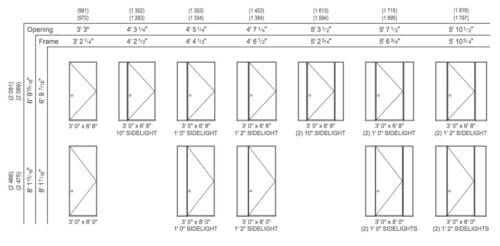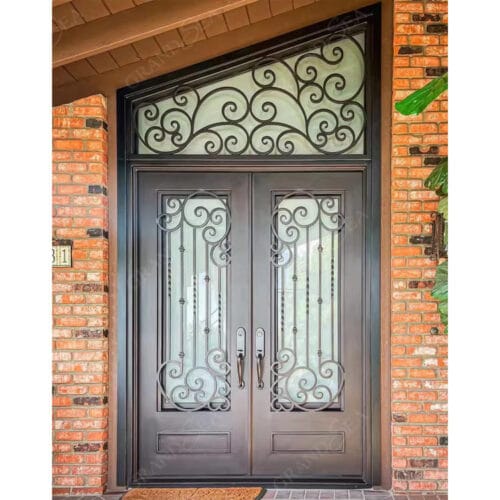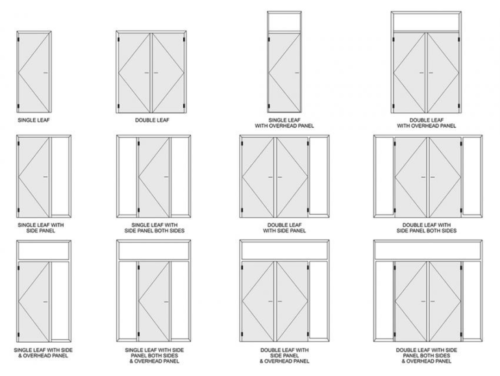A door not only acts as an entryway into a home but also serves as an integral component in reinforcing its visual identity and curb appeal, fulfilling both practical and decorative functions while contributing to overall facade coherence.
Yet many residential structures—especially those of historical importance or unique architectural design—deviate from contemporary dimension norms, making custom size exterior doors necessary and effective solutions. In these instances, custom-sized doors become essential.
Custom doors designed specifically to the dimensions and aesthetic requirements of existing structures not only ensure seamless physical integration but also enhance design continuity, material specificity, and performance optimization. Thus, installing one isn’t simply a matter of stylistic preference; rather, it plays a crucial role in maintaining both structural integrity and visual standards for the property.

Standard or Custom exterior Door Sizes
First things first, what exactly are standard exterior door sizes? Think of them as the most common measurements you’ll find. Standard exterior door widths typically range from 30 to 45 inches, though they are sometimes cited more narrowly as ranging from 30 to 36 inches. You might also see them referenced as measurements like 2/0 to 3/6, 3’ or 3’ 6”.
Standard heights usually range between 71 and 96 inches, with 80 inches (6 feet 8 inches) being a common standard. Other typical measurements include 6/8, 7/0, and 8/0 (or 6’ 8” and 8’). The standard thickness is usually about 1 ¾ inches or around 2 inches.
So, when do you need to step outside these standard ranges and go custom?
- Your existing door or opening doesn’t match these standard dimensions.
- You’re renovating an older home where non-standard sizes are common. Older homes were less likely built with standard features.
- You want to keep your existing door jamb. A trimmable door (more on those later!) can help with this hassle-free and potentially cut costs.
- You’re building a custom home and want unique dimensions from the start.
If your measurements fall outside those typical ranges, a custom size is likely the way to go.

Why a Tailored Fit Matters
Why Select the Ideal Size
Finding doors tailored specifically to fit the entryway offers numerous benefits beyond simply aesthetic appeal.
Functionality: Fit is of utmost importance. A door that fits precisely creates an airtight seal to prevent air leaks, stopping heated or cooled air from escaping and outside air from entering. This superior insulation not only reduces energy loss but also keeps out drafts and cold winds.
Longevity: Custom exterior doors are typically made with superior craftsmanship and higher-grade materials, providing a longer lifespan than stock options and saving you money in the long run.
Security: Custom-fitted doors enhance the security of any entryway by using durable materials such as fiberglass or steel, known for their inherent strength. Custom options might even feature impact-resistant glass and advanced locking mechanisms for further protection.
Curb Appeal and Aesthetics: When it comes to curb appeal and aesthetics, having the ideal size door makes an entryway truly distinctive and displays your individuality. Additionally, it adds visual interest while complementing the architecture of the home’s exterior.
Measuring Your Door Frame and Opening
Okay, this is perhaps the most crucial step! Accuracy is absolutely essential when measuring for a new door. Precise measurements ensure the door looks right, functions correctly, saves you energy, boosts curb appeal, and even enhances security.
Here are the key measurements you’ll need to take:
- Height: Measure from the top of the threshold (the piece along the bottom) to the underside of the frame at the very top of the opening. Remember to account for the threshold itself.
- Width: Measure horizontally from the inside edge of one side of the frame to the inside edge of the opposite side. It’s best to measure at the top, middle, and bottom of the opening. If your opening isn’t perfectly even, always use the shortest measurement to ensure the door will fit.
- Thickness: Measure the thickness of your current door to make sure the new one won’t protrude.
- Rough Opening: Standard doorway dimensions typically refer to the door panel itself, whereas the actual wall opening (the “rough opening”) accounts for additional space to accommodate the door frame.
- Hinges: If you’re replacing an existing slab and keeping the frame, measure from the top of the door down to the top of each hinge. Note both the height and width of the hinges.
- Borehole (for the handle): This one requires removing the current handle. Measure from the top of the door down to the centre of the borehole. Then, measure from the borehole centre to the nearest edge of the door.
If you feel uncertain about measuring, Grandsea can provide resources or consultations to guide you through the process.
Options for Achieving a Custom Size
Once you have your measurements, how do you get a door in that specific size? You have a couple of main routes:
- Completely Custom Built Doors: This is where you work directly with a manufacturer or craftsman to design and build a door from scratch to your exact specifications.
- The process typically involves finding inspiration for your design, submitting your ideas and details (like drawings or measurements), working closely with a design team to dial in the style, materials, and features, ensuring you take accurate measurements, choosing your materials (like wood species or metal), and selecting the perfect finish and hardware. Manufacturers like Grandsea even offer unlimited options in terms of sizes, panel configurations, and designs for their custom doors.
- Trimmable Doors: This is a super convenient option. Trimmable doors are pre-made but specifically designed with extra material so they can be adjusted to fit entryways that fall outside standard sizes or are conventionally sized but need a little tweak.
Choosing a trimmable door often eliminates the need to reconstruct your entire entryway to fit a new door.

Resizing the Rough Opening (Making it Bigger or Smaller)
What if your existing opening is really far off standard, and you want to change the structural size of the doorway itself? This is a bigger project.
- The Process: This involves removing the old door and its frame, then opening up the surrounding walls. An experienced contractor will expand or shrink the rough opening (the space where the door and frame are installed) by rebuilding the framing and potentially replacing the header (the supporting beam above the door). Once the new framing is done, the new door unit is installed, and the walls are repaired.
- Complexity: This task is generally regarded as a major undertaking.
- When it Makes Sense: Resizing the rough opening is best suited for a major remodel project where you’re already doing significant structural work.
- Professional Help: You will absolutely want to work with an experienced contractor or builder for this task.
Beyond the Basic Door: Adding Features and Considering Accessibility
A custom size exterior door provides an opportunity to make your entryway truly distinctive.
- Sidelights and Transoms: Think about adding windows next to your door (sidelights) or above it (transoms). These can add design interest and bring natural light into your home. It’s best to plan and order these accessories along with your custom door for a cohesive design.
- Door Swing Direction: Make sure you’ve decided whether the door will swing inward or outward. Whichever you choose, check that you have enough space for the swing so it doesn’t hit walls or furniture.
- Accessibility: When designing for accessibility, several important factors must be considered.
- Accessibility guidelines, such as those from the ADA (Americans with Disabilities Act), recommend a clear width of at least 32 inches when the door is open 90 degrees. This is vital for wheelchair users or people with other mobility aids to pass through comfortably.
- A smooth threshold no more than ½ inch high is also recommended to prevent tripping hazards and make access easier for everyone.
- Choosing custom sizes can allow for very precise dimensions to meet these needs; some companies can size doors in 1/8-inch increments.
Choosing custom sizes allows for precise dimensions to meet these needs. Some companies can size doors in increments as small as 1/8 inch.

Exploring Material and Design Options
Custom means choice! You get to pick the materials and design elements that best suit your home and style.
- Materials:
- Fiberglass: A popular choice due to its durability and low maintenance.
- Fiberglass doors can mimic the look of wood with realistic wood-grain finishes or offer a sleek smooth skin. They are naturally strong and offer excellent security features. Many fiberglass doors provide resistance to moisture, preventing rot, corrosion, warping, mildew, and mold.
- Wood: Offers timeless warmth, beauty, and strength. Wood doors can be highly customised in various species like oak, redwood, hemlock, cedar, or walnut. They can be finished with stains to highlight the natural grain or painted in custom colours. Companies like Pella offer advanced wood protection like EnduraGuard® and options like aluminum cladding for durability and weather resistance.
- Steel: Chosen for superior security and durability. Steel is naturally strong, weather-resistant, and low maintenance. It’s often selected without glass for maximum privacy and is resistant to rot. Steel doors are engineered for reliable performance and exceptional energy efficiency thanks to their airtight design.
- Design & Style:
- Choose a style that complements your home, whether modern, traditional, or something specific like Grandsea’s Limited, Modern, Onelite, Oak, or Nova Series.
- Select your glass options, such as doorlites (windows in the door), sidelights, transoms, or different configurations like full-light or half-light. You can also choose specific glass types, including Low-E for energy efficiency, impact-resistant for security, or obscure/decorative glass for privacy and style. Some doors are available “ready-to-glaze,” allowing you to add your preferred glass later.
- Pick your finishes, from a wide array of stains and paints, or even custom colours.
- Finally, choose your hardware (handles, hinges, locks) that tie the whole look together.
Common Mistakes to Avoid
Obtaining a custom door is an exciting process, but several common pitfalls should be avoided.
- Incorrect Measurements: As we’ve stressed, this is arguably the most frequent and critical mistake. You must accurately measure the height, width, and thickness of the existing door (if applicable) and, crucially, the rough opening, frame, and installation fin space.
- Ignoring Door Swing Direction: Don’t forget to decide if the door should swing inward or outward, and make sure there’s enough clear space for it to open fully without hitting anything.
- Overlooking Building Codes and Regulations: Check with your local municipality to ensure your new door meets all required building codes, including any accessibility requirements.
- Not Considering Insulation and Energy Efficiency: Don’t just focus on looks! Choose a door with good insulation properties, especially if you live in an area with temperature extremes. Energy-efficient glass options are also important.
- Mismatching Door Aesthetics: Your front door should enhance your home’s look. Make sure the style, material, and finish you choose complement your home’s architecture and colour scheme.
Avoiding these mistakes will help ensure your custom door is a perfect fit in every sense!
Getting Expert Help
Choosing and ordering a custom-size door might seem daunting, but you absolutely don’t have to navigate it alone.
- Consult Professionals: Working with experienced contractors or the design team at your chosen supplier can be incredibly helpful. They have the expertise to guide you through the process.
- Utilise Supplier Services: Many companies offer fantastic resources. Take advantage of things like free consultations where experts can help verify your measurements, offer design guidance, and walk you through your material and feature options. They can ensure the door you order will truly be a perfect fit for your unique entryway.
Conclusion
Choosing a custom size exterior door ensures a perfect fit that goes beyond simple measurements. It enhances your home’s energy efficiency and security, boosts curb appeal, and provides durability and longevity.
Whether you opt for a completely custom-built masterpiece or a convenient trimmable door, measuring carefully and exploring all the material and design options available is key.
Don’t hesitate to reach out to Grandsea’s professionals and utilise the resources offered by suppliers. With careful planning and the right help, you can find the perfect custom door to make your unique home shine!


